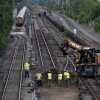Unless you're arriving by boat or plane, getting to Cape Cod requires traveling over a bridge. And for nearly 100 years, two bridges have served as the gateway to the Cape for hundreds of thousands of people in cars every year.
But the bridges are getting old, and they're not keeping up with the traffic like they used to. People are seriously asking if it's time to replace them with something newer — and bigger.
The Bourne Bridge and Sagamore Bridge were built in the 1930s to replace a series of old drawbridges across the Cape Cod Canal. Ironically, those drawbridges were replaced for the same reason there are calls to replace the bridges today — traffic.
Samantha Gray of the U.S. Army Corps’ Cape Cod Canal Visitors Center in Sandwich, said the Corps received complaints about cars jamming highways while waiting to cross the drawbridges back in the late 1920s.
"So the Corps of Engineers knew they were going to have to build elevated bridges that would allow vessels and vehicle traffic to travel at the same time," Gray said.
The Bourne and Sagamore bridges have changed little in 85 years, with lanes designed for Ford Model Ts rather than SUVs. The Army Corps of Engineers, which owns and maintains the spans over the Cape Cod Canal, is now considering whether to repair or replace the bridges.
The Massachusetts Department of Transportation thinks they should be replaced with new bridges. And so does Wendy Northcross, CEO of the Cape Cod Chamber of Commerce.
“They're going to be due for major repair in five to seven years anyway," Northcross said. "So this is a perfect time to be looking at: Is it more cost effective to recommend replacement?”
U.S. Rep. Bill Keating agrees. Keating said that simply repairing the current bridges would be a waste of money, and the longtime lane closures that would follow would cause significant traffic problems. It makes more sense to build new bridges, he said.
“You can keep the bridge open that's there, build a new bridge alongside of it, and that way you would be not wasting as much money and facing that kind of major disruption,” Keating said.
In June, the U.S. House passed a $5 million appropriation to design the new bridges, filed by Keating. That bill, which is still awaiting action in the U.S. Senate, is part of a national effort to target deteriorating bridges that are important evacuation routes. The canal bridges fall into that category because both bridges would be needed in the event of a serious hurricane.
The congressman said there's an urgent need for new bridges.
"We have to begin the actual design and planning now," Keating said. "Waiting a few years is going to place us in a situation where we have to do major reconstruction, [and] waste that money on repairing something that has other major structural problems."
The Army Corps was expected to release its decision about what should happen to the bridges this summer, though that date has been pushed back to later in September or October.
The two bridges, which cost about $3 million to build in the 1930s, would cost around $1 billion dollars to replace today.
The plans being considered by the Corps call for much wider spans than the current 48 feet. They would potentially need to be 138 feet wide, which would include two through lanes in each direction, auxiliary lanes for vehicles entering or exiting the highway, and room for cyclists and pedestrians.
Marie Oliva is a lifelong resident of Bourne, who now directs the Cape Cod Canal Regional Chamber of Commerce. She said widening the bridges is not just to accommodate more summer tourists, but to avoid the problems that come with having to accommodate necessary year-round repair work.
“When they have to paint the bridge or fix the bridge, we've got two to three-hour traffic jams, and sometimes longer, coming through our community,” she said.
The state DOT has some plans of its own. It would like to eliminate the Bourne Rotary and make changes to some nearby roadways to improve the approaches to both bridges. But the state can't follow through on its plans until the Army Corps decides whether to repair or replace the Sagamore and Bourne Bridges.
The decision can't come soon enough for Oliva. She said even though the new bridges are needed now, they are still years away from becoming reality.
“So, we are taking five to seven years, but that's only if everything goes according to plan,” she said.
There's a lot that has to go right in a relatively short time. And even if it does, construction of the new bridges and all of the reconfigured approach roads may take until 2040. By that time, state officials expect the number of vehicles crossing the two bridges to increase nearly 27 percent during the summer from 122,000 to 155,000.





